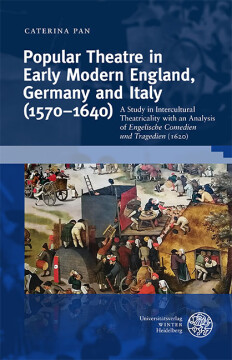
BUCH
Popular Theatre in Early Modern England, Germany and Italy (1570–1640)
A Study in Incultural Theatricality with an Analysis of ‘Engelische Comedien und Tragedien’ (1620)
Wissenschaft und Kunst, Bd. 38
2023
Zusätzliche Informationen
Bibliografische Daten
Abstract
This study explores the influence of English and Italian itinerant companies on early modern German theatre. A central aspect that mediated this intercultural adaptation is ‘popular culture’, i.e. a network of shared knowledge, which was successfully employed by the English Comedians to meet and shape the taste of their audiences. The analysis of the first and most important collection of playtexts attributed to them, “Engelische Comedien und Tragedien” (1620), according to four parameters (‘Memorialisation’, ‘Hybridisation’, ‘Adaptation’,’ Visualisation’) shows clear influences both from Elizabethan drama and Commedia dell’Arte and offers an innovative transversal perspective on the development of early modern popular theatre in Germany and Austria as a Product of intercultural theatricality.
Inhaltsverzeichnis
| Zwischenüberschrift | Seite | Aktion | Preis |
|---|---|---|---|
| Cover | C | ||
| Title Page | III | ||
| Imprint | IV | ||
| Acknowledgements | VII | ||
| Contents | IX | ||
| Introduction | 1 | ||
| 1. Theoretical Framework | 15 | ||
| 1.1. Early Modern 'Popular' Culture and Theatre – A Definition | 17 | ||
| 1.2. Adaptation as Intercultural Process in the Renaissance | 23 | ||
| 1.3. Intercultural Theatricality: Inter-Theatricality, Recognition and Reader-Response Theory | 29 | ||
| 2. Early Theatricality in-between Popular Orality and Erudite Literacy | 33 | ||
| 2.1. Ritual and Lay Theatre: Mummers' Plays, Mysteries, Morality Plays and Interludes | 37 | ||
| 2.2. Fools and Clowns from the Middle Ages to the Renaissance | 44 | ||
| 2.3. Tradition and Innovation in the Emerging Professional Theatre | 50 | ||
| 3. Commedia dell'Arte in Italy and Northern Europe | 55 | ||
| 3.1. The Art: Origins and Maturation | 60 | ||
| 3.2. The Skills: Masks and Characters | 64 | ||
| 3.3. The Trade: Troupes, Actors and Repertoire | 75 | ||
| 4. Elizabethan Theatre and the Italianate Influence | 85 | ||
| 4.1. Professional Companies: From Courtly Patronage to Public Entertainment | 88 | ||
| 4.2. The Making of a Play: Italian and English Parallels | 93 | ||
| 4.3. Shakespeare and Commedia dell'Arte – A Brief Survey | 99 | ||
| 5. The English Comedians in Germany and Austria | 107 | ||
| 5.1. The Four Phases of Influence | 113 | ||
| 5.2. The First 'Ambassadors': Kemp, Browne & Co. | 123 | ||
| 5.3. Browne's Successors and the Continental Repertoire | 133 | ||
| 6. Intercultural Theatricality in ‚Engelische Comedien und Tragedien‘ | 155 | ||
| 6.1. The Religious Plays: ‚Esther and Von dem verlornen Sohn‘ | 162 | ||
| 6.2. Fantastic and Pastoral Comedies: ‚Von Fortunato, Von eines Königes Sohne‘ | 175 | ||
| 6.3. Comedies with 'Types': ‚Von Sidonia und Theagene, Jemand und Niemandt‘ | 190 | ||
| 6.4. The 'Shakespearean' Tragedies: ‚Von Julio und Hyppolita, Von Tito Andronico‘ | 204 | ||
| 6.5. The Clown's Domain: ‚Pickelheringspiele and Singspiele‘ | 223 | ||
| 6.6. The Parameters at Work in the Collection | 240 | ||
| 7. The German and Austrian Stages as Competition and Melting Pots | 251 | ||
| 7.1. ‚Der Jud von Venedig‘ – Synthesis beyond the 1620 Collection | 252 | ||
| 7.2. English and Italian Traces in Duke Heinrich Julius, Jacob Ayrer and Andreas Gryphius | 263 | ||
| 7.3. Arlecchino, Pickelhering and Hanswurst/Kasperl – Rivals or Brothers? | 277 | ||
| Conclusion – A New Perspective on Early Modern Popular Theatre | 287 | ||
| Bibliography | 293 | ||
| List of Illustrations | 305 | ||
| List of Abbreviations and Glossary | 307 | ||
| Backcover | 309 |


 Publishing Platform by CloudPublish
Publishing Platform by CloudPublish